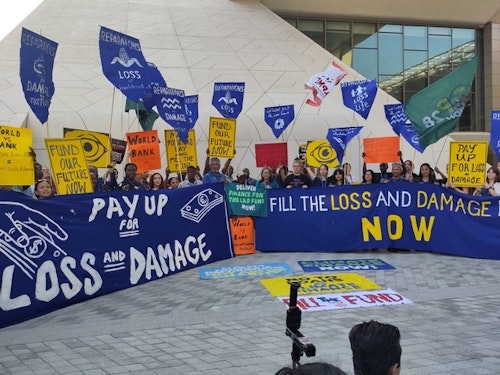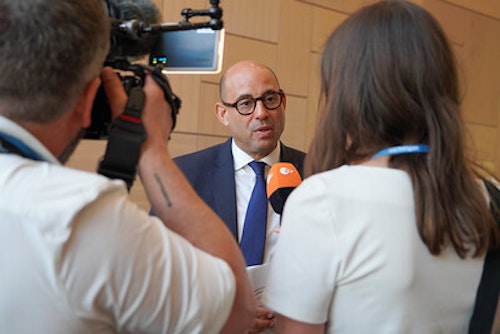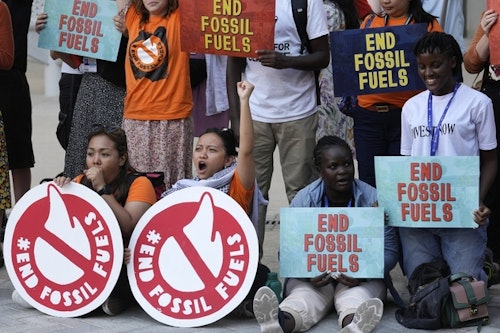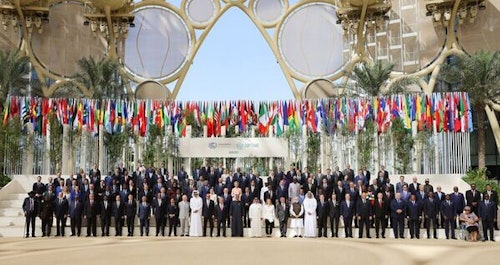The UN conference continues, as 2023 becomes the world's hottest year on record.
Welcome to our coverage of COP28 from Dubai. Stay tuned for the latest updates from the UN climate conference.

 ${title}
${title}
Live ended
That’s a wrap on today - and the first week of COP28, as delegates take a rest day tomorrow. We’ll be resting the blog tomorrow too, but are back on Friday as talks enter their final phase.
There’s currently everything to play for. “Negotiations, as are often the case, are a mixed picture right now. We see big differences between individual states in some areas,” German climate envoy Jennifer Morgan told reporters, “but there is a will to make progress.”
Today has seen a new statement on urbanisation and climate change, leveraging the expertise of local leaders. And there’s been countless fruitful discussions across the summit on the wider themes of transport and city life.
It’s been an alarming day for the Ukrainian delegation, as Russian president Putin touched down to a warm welcome in nearby Abu Dhabi.
And climate scientists are continuing to spell out the extreme danger that climate inaction is placing us in. 2023 is now the hottest year on record, according to Europe’s climate monitor, the Copernicus Climate Change Service.

World’s 10 largest concrete and cement companies unite to decarbonise
An announcement from earlier in the week, but one pertinent to today’s built environment theme. The world’s 10 largest concrete and cement companies are getting serious about decarbonising their highly polluting industry, according to a new report.
Cemex and Holcim, the biggest cement producers in the UK and US respectively, are among the stakeholders in a new strategy to get to net zero emissions within 25 years.
These two titans of the material world are responsible for 8 per cent of global CO2 emissions: more than aviation and shipping combined.
A new partnership between the big firms, architects, engineers and other experts includes the first net zero strategy anchored in “granular economic modelling”.
“Our report sets out precisely what needs to happen to make zero carbon concrete and cement a reality, but time is not on our side,” says CEO of Mission Possible Partnership, which has spearheaded the strategy.
“The moment to roll up our sleeves and work together across the value chain and with governments is now. Immediate collaboration and cooperation - from producers through design and construction - together with policymakers and finance - is essential to making the necessary progress this decade.”
Putin welcomed to the UAE during COP28
US Special Presidential Envoy for Climate John Kerry was one significant visitor to Ukraine’s pavilion earlier today.
But Ukrainians in Dubai were disturbed to hear that Russian Vladimir Putin touched down to a warm welcome in Abu Dhabi around the same time.
More on this news story here: Russian President Vladimir Putin visits UAE and Saudi Arabia during COP28
UAE pulling out all stops to receive Putin with pomp in Abu Dhabi. pic.twitter.com/ut0NOBbEUo
— Yaroslav Trofimov (@yarotrof) December 6, 2023
The symbolic reason behind Ukraine’s ‘house’ pavilion
It’s not easy to wander past Ukraine’s pavilion. In contrast to the huge, hangar-like areas where countries set out their stalls at COP27 in Sharm El Sheikh last year, Dubai’s Expo City venue has the pavilions tucked away in many different buildings.
But those who visit the Ukrainian delegation are met by a striking sight: a submerged house with real roof tiles, surrounded by a floor rippled to look like water.
“It’s a visualisation of the houses that are flooded by the fallout of the explosion of the Kakhovka Dam [on Ukraine’s Dnipro River] conducted in June this year,” explains 18-year-old Vladyslav Levchuk, a youth advisor with UNICEF Ukraine.

“And what's also precious in this context is that the roof on this house has lived through the First World War, the Second World War, and also has seen exactly what the Russians conducted. So it's like a long history in this roof.”
Other real life materials - including contaminated soil, burnt tree bark and bombed grains - have been brought in as testament to the environmental damage of Russia’s invasion. While VR technology shows how Ukraine is rebuilding using green energy methods.
For example, the DTEK Tyligulska Wind Power Plant was launched in May this year - becoming the first such plant to be built during wartime. A narrow design is helping to protect it from being bombed, and so continue powering around 200,000 households with clean electricity.
“We want our energy system to be safe. We want our ecology to be secure and the compensations back, and also [we want] the Russian Federation to be attributed with ecocide in accordance with international law,” says Vladyslav, who is also a law student “living in the era of blackouts”.
What has been achieved on urbanisation day?
Earlier today the COP28 presidency held a ministerial meeting on urbanisation and climate change, alongside the United Nations Human Settlements Programme (UN-Habitat) and Bloomberg Philanthropies.
The result is a ‘Joint Outcome Statement on Urbanization and Climate Change’, supported by dozens of national ministers of environment, urban development and housing. It lays out a 10-point plan to build climate action into different levels of government, and make sure enough adaptation finance is reaching cities.
As many as 90 per cent of cities are threatened by rising sea levels and storms, and their residents are exposed to 10 degrees higher temperatures than those in rural areas, the leadership notes.
“We are empowering and supporting cities on the frontlines of climate change to seize the initiative,” says COP28 President Sultan Al Jaber. “We have brought over 450 mayors and governors to COP28 and their hyperlocal knowledge is crucial in informing our global solutions.”
With cities contributing more than 70 per cent of the world’s CO2 emissions, it's essential they have the right designs to decarbonise, as well as withstand fiercer floods, heatwaves and droughts. More money would help them to re-design themselves.
Campaigners call for Loss and Damage fund to be filled - and call out fossil fuel enablers
Climate activists gathered at a protest area inside the blue zone this afternoon to make a vocal stand on COP’s key issues.
Their main demand? Fill the newly created Loss and Damage fund.
“We are not going to stop just because we have got a fund; the next step is: build the fund. The fossil fuel industry is making profits of $4 trillion annually,” said Harjeet Singh, head of global political strategy at Climate Action Network (CAN). While pledges for the fund for climate victims currently stand at around €700 million.
“Please don’t be fooled,” he added, “it’s nothing compared to the profit the fossil fuel industry is making."

Singh bemoaned the record number of fossil fuel lobbyists revealed to be at COP28.
And he said that the adaptation fund is "suffering", ending with a call to scale up both forms of climate finance to the tune of hundreds of billions of dollars.
Food shortages and major cities flooding: The tipping points that could endanger us all
The aim of the report is to get governments to act now rather than consider what might be accomplished in a few years time.
More than 200 scientists contributed. Lead author Professor Tim Lenton from the University of Exeter spoke about some of the tipping points that could devastate lives in the US and Europe:
“Right now, even at 1.2°C of global warming, we're running a significant risk of some fast tipping points, including we're seeing the loss of coral reefs, which 500 million people depend on for their livelihoods. We're also running a risk of a tipping point in the North Atlantic circulation that within a decade could make the climate far more seasonal in the UK and Western Europe, thus reducing the growing season of major crops by two months or more. In simple terms, precipitating a food and water security crisis whilst at the same time raising the sea level on the north east seaboard of America. So Boston and New York, for example, by ten or tens of centimetres, posing a serious challenge if we have another storm Sandy.”
Dr Manjana Milkoreit, co-author, University of Oslo says global governance is inadequate in the face of this challenge.
She says part of the problem is that decision makers don’t have the science or the communication structure to prompt change from a government to a community level.
“We do observe that that applies not just to the broader public, but also to decision makers. So some of our research, it's very limited research that we have about what decision makers actually know about tipping points. But what we do know is that it's significantly lagging behind the knowledge we have in the sciences itself. So there is a communication task ahead of us to help decision makers engage with this concept, to learn about it, and to become more comfortable making choices about it,” says Milkoreit.

"Good intentions won't halve emissions"
The Executive Secretary of UN Climate Change has pushed for negotiators to put their money where their mouths are, saying nothing will happen without finance.
Speaking to press in Dubai, Simon Stiell said that negotiators have a "starting text on the table" over the Global Stocktake.
"Finance is the great enabler for climate action. The negotiations must put it front and center.
Loss and damage was a win, but we’re kidding ourselves if we think it’s a tick in the box for finance and support at this COP; more is required. We need enhanced transparency, and to deliver our promise to fund climate action across the world.
Let’s be honest - good intentions won’t halve emissions this decade or save lives right now. Only serious progress on finance can deliver frontline results."
The Euronews TV team has produced this report from the conference.
They heard from the COP28 CEO as well as activists protesting around the site.
Activists say frustration levels are high
COP28 boasts almost €80 billion so far
COP28 has mobilised over $83 billion (€77.3 billion) for climate finance in its first five days, according to the presidency.
Delegates can’t miss the sight of progress: it’s being blown up on giant screens at the impressive Expo City venue.

A rotating series of messages are informing attendees that 11 pledges and declarations have been launched.
These include the Global Renewables and Energy Efficiency Pledge, endorsed by 123 countries; the Declaration on Climate and Health, with 132 nations behind it; the Declaration on Climate Finance, endorsed by just 13 countries; and Oil and Gas Decarbonization Charter which has been endorsed by 52 companies, representing 40 per cent of global oil production.
Meanwhile the $83 billion includes $726 million (€672 million) in Loss and Damage pledges.
2023 is officially the hottest year in history
It was already virtually certain, but Copernicus, Europe’s Climate Change Service, has now declared that 2023 will be the hottest year in recorded history.
November was the sixth consecutive month to break records: with an average daily temperature of 14.22 degrees Celsius, exceeding 2020's record by 0.32 degrees.
“There have been new records for six months in a row and two seasons. This extraordinary November means that 2023 will be the hottest year since records began," says Samantha Burgess, the deputy director of the service.
Here’s more on this story: Copernicus: 2023 officially hottest year in recorded history
Good morning from COP28 in Dubai!
The conference is approaching a mid-point, with negotiators soon to hand over to ministers to thrash out the final details of key texts on the global stocktake, fossil fuels and more.
Around this negotiating core, today’s focus turns to transport, urbanisation and the built environment - colossal sectors that need to decarbonise urgently.
It comes as the Global Tipping Points report is released, showing that five vital thresholds already risk being crossed. The collapse of vast ice sheets in Greenland and the West Antarctic and the death of coral reefs in warm waters are two such shifts that could trigger “devastating domino effects,” according to report lead Tim Lenton from the UK's University of Exeter.
At various events today, city and transport leaders will be discussing what they can do to reduce the carbon pollution that is fuelling the climate crisis. There’s also a four-hour long 'global sustainable aviation forum' - though it’s less clear what that will achieve.
Stay with us for the latest news from COP28. And catch up below on what you missed yesterday.

Record fossil fuel lobbyists, Europe's deadly emissions and cooling pledges on day 6
An analysis by the Kick Big Polluters Out (KBPO) coalition revealed that at least 2,456 fossil fuel lobbyists have been granted access to COP28. They say that is significantly more people than almost every country delegation. Only Brazil with 3081 people and the host country UAE with 4409 outnumber them.












